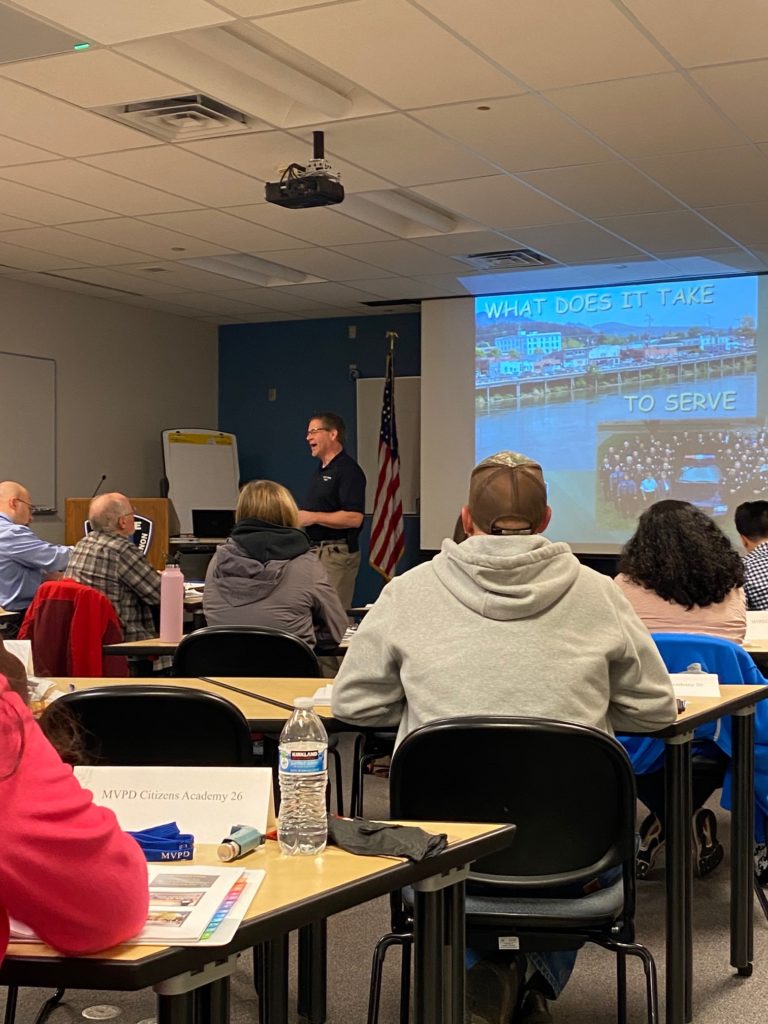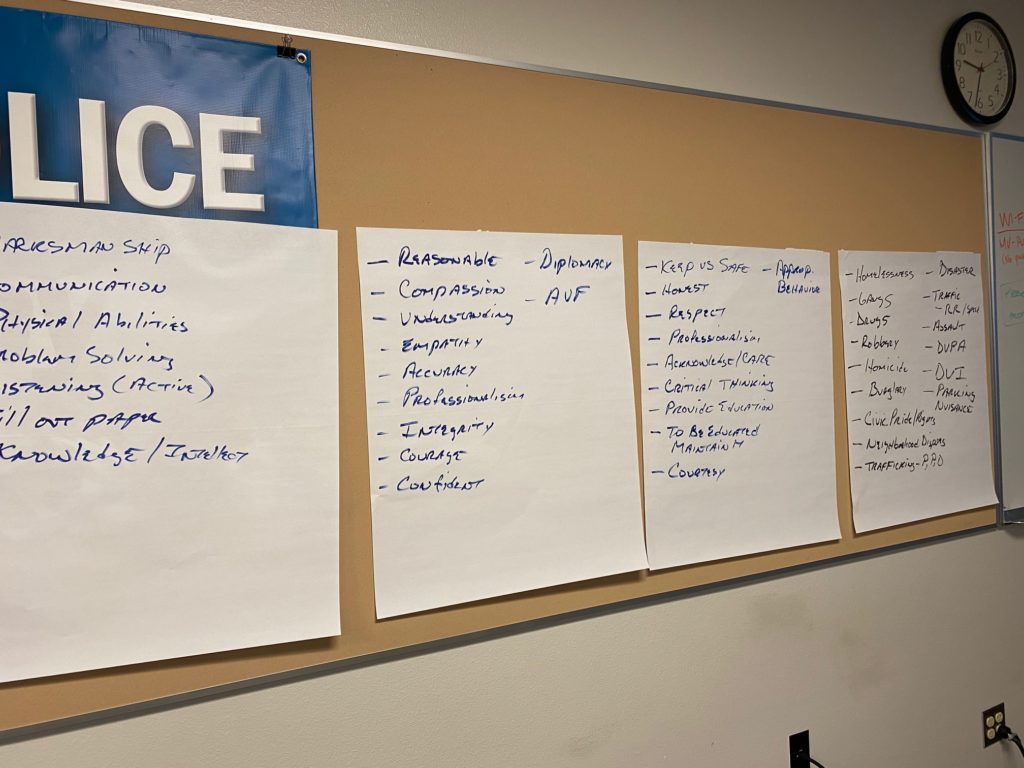Citizens Academy: The Right Stuff

In the second session of “Cop Class,” we learned about what it takes to become one of Mount Vernon’s finest, and how rigorous hiring procedures help ensure that only the best of the best put on the blue uniform. And although most of us think of policing in terms of those who wear that uniform, session two of Citizens Academy also acquainted us with two less visible aspects of policing that are as integral to its success as patrolling our neighborhoods and responding to criminal incidents: record keeping and evidence handling.
In this episode of Citizens Academy: Inside Cop Class, we’ll focus on the subject of hiring — a subject taken up by none other than Chief Chris Cammock, whose objective for the class were to leave us with an understanding of what it takes to be a Mount Vernon police officer, and an insight into the hiring process that ensures the selection of those whose skills, temperament and values match the law enforcement needs of our community.
What it Takes to Serve and Protect

In considering the job qualifications for a commissioned police officer with the MVPD, Chief Cammock led our class through some “group think” exercises that started with the most important job description definer: “What sort of issues face Mount Vernon that you think the police should be prepared to handle?” Although Mount Vernon may not be a big city, it nevertheless shares the same types of crime, albeit on a smaller scale. These include:
- violent crime (assaults, robbery, homicides)
- property crime (burglary, theft, vehicle prowl, graffiti)
- gang activity (violence, intimidation, encroachment)
- drug activity
- traffic incidents (speeding, hazards, congestion, accidents, fatalities)
- public demonstrations (parades, pickets, marches)
- internet crime (identity theft, fraud, scams)
- abuse (elderly and child)
- illegal immigration issues
- homelessness (pan handling, begging, mental health issues)
- animals (abuse, neglect, bites, lost/found)
Keeping in mind our needs, the logical next consideration is what we expect from our police in meeting them — which was the next “group think” exercise that Chief Cammock led. In response, the resulting list of expectations touched on exactly the kinds of values you might expect: trustworthiness, a strong desire to help others, tolerance, a strong “can do” mentality, leadership, and professionalism. Oh…and let’s not forget courage, confidence, and a well honed appreciation for the use of force (a future episode in its own right).

In addition to these essential traits, there are a plethora of skills to be developed before a police officer can set foot on the street. Many of these were obvious to Citizens Academy attendees: marksmanship, knowledge of the law, physical and mental fitness, listening and problem solving skills, and the ability to communicate effectively. But Chief Cammock added a number of others that were less obvious: organizational skills and attention to detail, basic computer and technology literacy, and particularly in a community such as ours, multi-cultural awareness. If all this makes the ideal job candidate sound a bit like a social worker packing heat, you’re definitely catching on. And keep in mind that not all our men and women in blue carry a sidearm.
The reality of day to day policing has far more dimensions to it than our stereotypic image of the police officer cruising the mean streets in their patrol car or responding to a 911 dispatch. While every MVPD officer has to be competent in the basics of law enforcement, there are also specific areas of expertise that lend themselves to individual interests and innate skills.
“You have to be able to work a variety of shifts and enjoy being involved in neighborhoods,” says Chief Cammock, “but there are a number of other relevant skills we look for. There are officers who teach K – 6th grade level students. There are people that want to be on the tactical side of policing for situations when voluntary persuasion doesn’t work — which may also involve crisis negotiation. Some people want to ride a motorcycle, which is one of the hardest schools in policing. There are people who like to solve puzzles after the lights and sirens and adrenaline have subsided and who like the application of evidence collection methods. We need trainers and instructors for field training in a variety of areas. Our canine officer may work from 7 at night to 3:30 in the morning, and then might be called back in the middle of the day to run 5 miles into a wooded area without knowing what he will face — and still have an animal to take care of when he gets home. We need people who can address gang issues, and those who have a gift for getting things done through delegation and supervision.”
The Selection Process
With the kind of job description that emerges from all these considerations, it shouldn’t come as a surprise that the process of recruiting, vetting, and hiring police officers is a long and rigorous exercise. The process starts with a written test, which candidates can retake after three months if they don’t like their score. The process continues with a background investigation (handled by MVPD’s own criminal investigation team), meet & greet and ride alongs (“Candidates need to know if it’s a right fit, so we give them all the exposure to our agency as possible,” says Chief Cammock), and command staff interviews. Chief Cammock notes that the purpose of the oral interviews is not so much about the “right” answers to questions but how the candidates defend their answers. Other examinations include medical, psychological, and drug screen. There is also a polygraph test, which is historically where the highest percentage of candidates “wash out” of the hiring process. Once all these hurdles are cleared, a prospective police officer is placed on the hiring list.

As stringent as the process itself may seem, it also involves a broad level of participation by department and city personnel. These include the mayor and city council, the civil service commission, the chief of police, the administrative services lieutenant (the position Chief Cammock formerly occupied), the human resource director, the members of the oral board panel (which includes citizen participation), as well as department recruiters, background investigators and staff. It might seem like overkill, but as Chief Cammock reminds the Citizens Academy class, there’s a lot at stake. “At the end of the day, citizens want to feel safe and know that their civil rights are protected in the process. People want the law upheld, and now they really want to be involved. We have a process that is open minded and engaging, but there are complex issues and high liabilities that go with our profession, so we want people with similar values. People problems take special people to address them, and not everyone is wired to deal with people problems.”
So, what happens when a position opens opens in the MVPD, and a candidate goes from qualification to waiting list to job offer? Unlike the employment situations that the vast majority of us will encounter in our lifetimes, the successful applicant doesn’t show up for work the next day. Instead, a probationary period begins during which training takes place — and the training is even more rigorous than the hiring process. First comes 16 weeks of basic law enforcement academy, followed by 12 weeks of field training, 25 hours of in-service training, job assignment training, supervisor training, mid-management training, and executive training. Do the math, and the bottom line result is that a year and a half will transpire before a new police hire will find herself or himself on the street.
The Winnowing
Another way to look at the math involved in hiring “the best of the best” is the case of the four most recent MVPD hires. Out of 156 candidates who passed the written and physical ability tests…
- 63 of those passed the oral board interviews
- 20 of those passed the polygraph test
- 13 of those passed the job suitability assessments
- 7 of those passed the background investigations
- 5 of those passed the command and mayor interviews
- 4 of those passed the psychological/medical screens
The stringency of deciding who dons the blue uniform is such that at present, notes Chief Cammock, the department will be down five positions in a couple of months due to pending retirements. And once a officer does clear all the hiring and training hurdles, there is no guarantee that they’ll want to remain on the job after they experience its daily challenges. Case in point: not long ago a new officer opted out of the department after dealing with a domestic violence call followed by a suicide incident. To paraphrase a biblical passage, many are called but few are chosen — and not all choose to remain. As to the possibility that a “bad apple” might slip through, Chief Cammock observes that the issue is less about “bad people” and more to do with “skill sets that don’t match up on the job.”
So the next time one of Mount Vernon’s finest drives past, a salute would be in order, but a friendly wave will suffice. After all, you don’t do this job unless you really love your community. As we came away from the second session of Citizens Academy, we were far more likely to wonder not about the degree to which a person deserves to serve our community as a law enforcement officer, but the degree to which our community deserves that individual and their service to us. There’s no doubt, however, as to how Chief Cammock and the women and men who serve in the MVPD would answer that question.
See you in cop class!